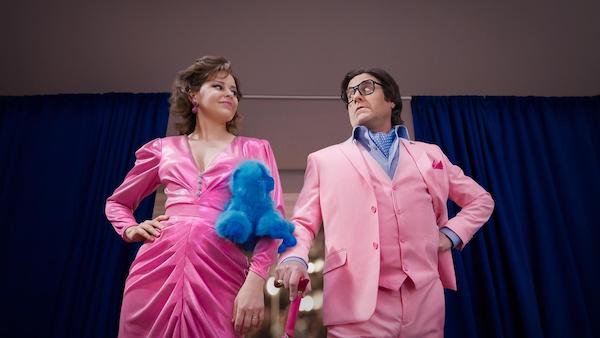Film Review: “The Beanie Bubble” — Much Ado About a Sack of Beans
By Sarah Osman
Like many fads from the ’90s and early aughts, Beanie Babies are now getting the Hollywood treatment.
The Beanie Bubble, directed by Kristin Gore. Streaming on AppleTV+

Elizabeth Banks and Zach Galifianakis in a scene from The Beanie Bubble.
Like many children of the ’90s, my sister and I had a collection of Beanie Babies. My mom thought they were cute; she even bought us a happy meal (to share) for one of the mini Beanie Babies, Patti the Platypus. She was also amused by the Beanie Baby-crazed collectors who believed that a hefty investment in colorful, bean-stuffed sacks would lead to early retirement. She often made fun of them. How could any adult think Legs the Frog would be the key to funding their child’s college education?
Like many fads from the ’90s and early aughts, Beanie Babies are now getting the Hollywood treatment. For some reason (nostalgia? needling the boomers?), a number of recent movies have centered on the rise and fall of businesses during that supposedly happy era. Politically, these films may be reminders that the ’90s weren’t so great, certainly not as a guilt-free distraction from the chaos of our current day. The latest entry is The Beanie Bubble, which sets out to explain how the Ty corporation addicted people to its product — to the point of a crazed mob stampeding a flipped-over truck filled with the cuddly critters. At times mildly funny and entertaining, The Beanie Bubble suffers from a debilitating identity crisis. The film can’t figure out if it is a wild farce, a drama about American business, a capitalist satire, or just a straight biopic of Spooky the Ghost.
The Beanie Bubble attempts to pull off a nonlinear narrative, bouncing among the doings of three women who made Beanie Babies a runaway success. Jumping back and forth between the ’80s and the ’90s isn’t confusing to follow, but dealing with multiple voices makes it difficult to latch onto the narrative arc of one specific character. The overall storyline revolves around Ty Warner, played by Zach Galifianakis. Warner is immediately established as an eccentric wheeler-dealer who should not be trusted (one character comments upfront that Warner is hiding something). We are given glimpses of the cracks in the guy’s plastic armor, but he never rises above being a caricature. This is not the fault of Galifianakis, who tries his best to turn in a performance that is more serious than comedic. The script is not nuanced enough (or certain enough of itself) to envision Warner as a formidable force. Instead, he’s treated as a somewhat cartoonish villain.
The first woman in Warner’s life is Robbie (Elizabeth Banks), his bored and unsatisfied neighbor, who decides to go into a business selling stuffed Himalayan cats. It’s never fully explained how that modest entrepreneurial dream morphed into the successful Ty corporation. All we learn is that, by 1993, Beanie Babies were bringing in enough money to call for international expansion. This is also the year we meet our other two leading ladies: Shelia (Sarah Snook), who eventually becomes engaged to Ty and whose two daughters help design the Beanie Babies, and Maya (Geraldine Viswanathan), who is initially hired as a receptionist but proves to be a marketing genius. It’s Maya’s idea to manufacture limited runs of certain Beanie Babies to drive up demand; she creates a web presence for the company as well. As a business film, Maya’s story is the most interesting. She is the real mastermind behind the craze, so it would have made more sense to tell the story from Maya’s point of view. Her relationship with Ty is the only nonromantic one among the protagonists, which would have tilted the film toward being a vision of commerce. If this was intended to be a movie about the rise and fall of Beanie Babies, then that is where the action was.
Every actress here turns in a fine performance. But they are let down by a mediocre script. Particularly baffling: we don’t see Warner’s eventual demise. It is never made clear how or even when Beanie Babies fell out of fashion. Given that we witness Warner’s despicable behavior, it is important that we see his, and the product’s, downfall. We don’t, so the film lacks a proper climax. Considering how strange the real rise and fall of Beanie Babies was, a documentary would probably have worked better. Why make up anything when the truth is far stranger than fiction?
Sarah Mina Osman is a writer residing in Wilmington, NC. In addition to writing for the Arts Fuse, she has written for Watercooler HQ, Huffington Post, HelloGiggles, Young Hollywood, and Matador Network, among other sites. Her work was included in the anthology Fury: Women’s Lived Experiences in the Trump Era. She is currently a first year fiction MFA candidate at the University of North Carolina Wilmington. When she’s not writing, she’s dancing, watching movies, traveling, or eating. She has a deep appreciation for sloths and tacos. You can keep up with her on Twitter and Instagram: @SarahMinaOsman
